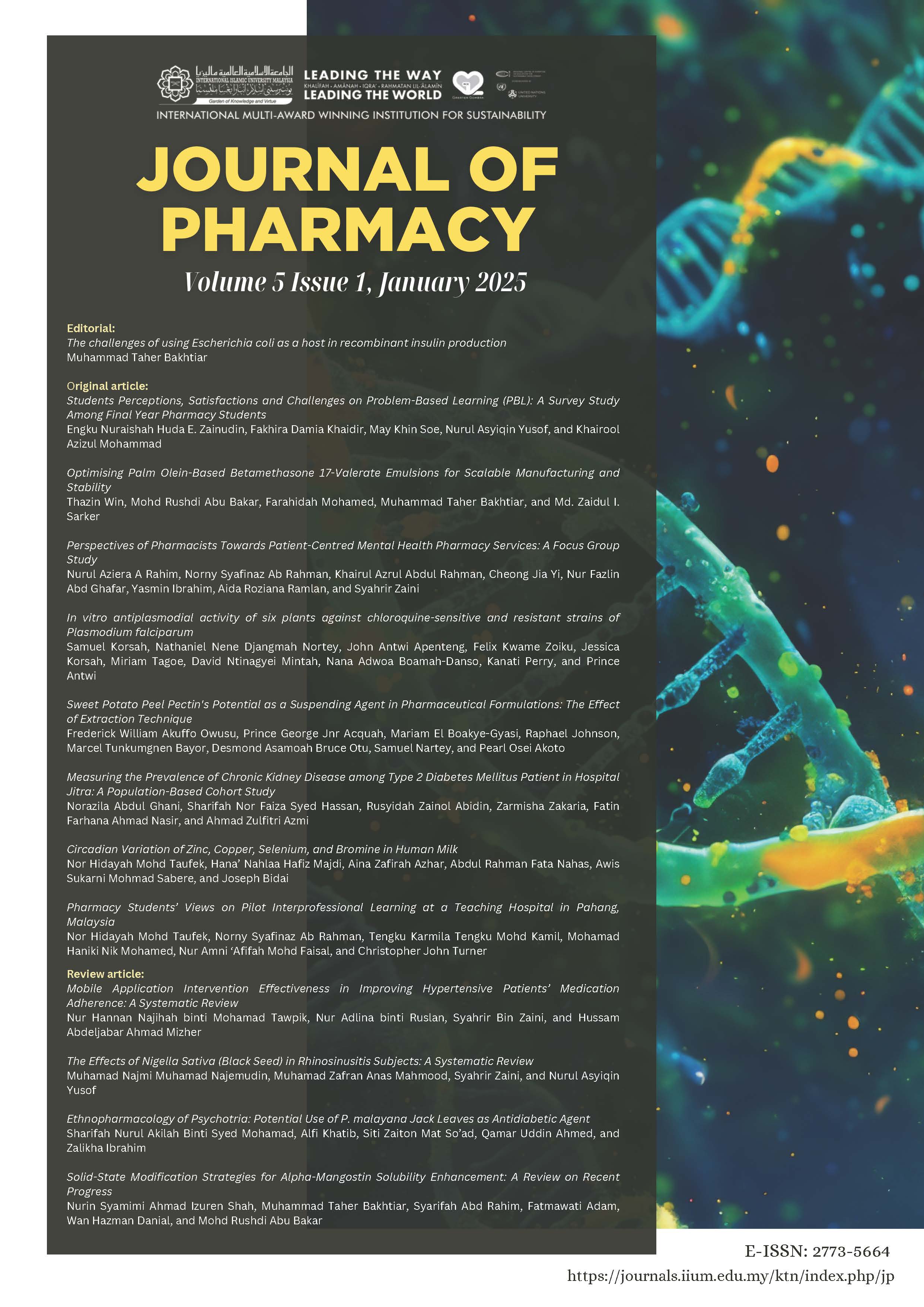The challenges of using Escherichia coli as a host in recombinant insulin production
Main Article Content
Abstract
Diabetes mellitus is a metabolic disease characterised by elevation of blood glucose level which leads to serious damage to the blood vessels, eyes, heart, kidney, and nerves affecting about 830 million people worldwide. The most common diabetes is type 2 which usually happened in adults when the body becomes resistant to insulin, or the body does not produce enough insulin. Type 1 diabetes mellitus is dependent on insulin which required accessible and affordable insulin (Diabetes, 2025).
In Malaysia, the prevalence of diabetes mellitus (DM), depends on factors such as gender, age, and ethnicity, with women, the elderly, and the Indian community having the highest prevalence of DM. In the 103,063 participants that made up the study's sample, the combined prevalence of diabetes by gender in the population-based studies was 13.80% for men and 14.54% for women, while the combined prevalence of prediabetes was 11.40% for women and 10.98% for men (Akhtar et al., 2022). For age, from this study, it can be observed that the prevalence of diabetes showed a notable upward trend as people aged, rising from 3.16% in the 20–29 age group to 13.71% in the 30-45 age group, 25.66% in the 46–59 age group, and 33.45% in the 60 and older age group (Akhtar et al., 2022). Ethnicity and races can also affect the prevalence of DM. The subpopulation of Indian had the greatest prevalence of diabetes which is 25.10%, among all ethnic groups, followed by Malay with 15.25%, Chinese with 12.87%, Bumiputera with 8.62%, and others with 6.91%. The prevalence demands oral hypoglycaemic agents (OHAs) market size in Malaysia at USD282.22 million in 2025 with a CAGR of greater than 3% during forecast period (2025-2030). The drugs are mainly fall under the following segment: biguanides, alpha-glucosidase inhibitors, dopamine-d2 receptor agonists, sodium-glucose cotransport-2 (SGLT-2) inhibitor, dipeptidyl peptidase-4 (DPP-4) inhibitors, sulfonylureas, and meglitinides (Malaysia Oral Anti-Diabetic Drug Market Size | Mordor Intelligence, 2025).
Article Details

This work is licensed under a Creative Commons Attribution 4.0 International License.
Journal of Pharmacy at https://journals.iium.edu.my/ktn/index.php/jp is licensed under a Creative Commons Attribution 4.0 International License.
References
Akhtar, S., Nasir, J. A., Ali, A., Asghar, M., Majeed, R., & Sarwar, A. (2022). Prevalence of type-2 diabetes and prediabetes in Malaysia: A systematic review and meta-analysis. PLOS ONE, 17(1),e0263139.https://doi.org/10.1371/journal.pone.0263139
Arya, R., Bhattacharya, A., & Saini, K. S. (2008). Dictyostelium discoideum—A promising expression system for the production of eukaryotic proteins. The FASEB Journal, 22(12), 4055–4066. https://doi.org/10.1096/fj.08-110544
Baeshen, N. A., Baeshen, M. N., Sheikh, A., Bora, R. S., Ahmed, M. M. M., Ramadan, H. A. I., Saini, K. S., & Redwan, E. M. (2014). Cell factories for insulin production. Microbial Cell Factories, 13(1),141.https://doi.org/10.1186/s12934-014-0141-0
Bhatwa, A., Wang, W., Hassan, Y. I., Abraham, N., Li, X.-Z., & Zhou, T. (2021). Challenges Associated With the Formation of Recombinant Protein Inclusion Bodies in Escherichia coli and Strategies to Address Them for Industrial Applications. Frontiers in Bioengineering and Biotechnology, 9, 630551.https://doi.org/10.3389/fbioe.2021.630551
Carrió, M. M., & Villaverde, A. (2003). Role of molecular chaperones in inclusion body formation. FEBS Letters, 537(1–3), 215–221. https://doi.org/10.1016/S0014-5793(03)00126-1
Diabetes. (2025). https://www.who.int/health-topics/diabetes
Ferrer-Miralles, N., & Villaverde, A. (2013). Bacterial cell factories for recombinant protein production; expanding the catalogue. Microbial Cell Factories, 12(1), 113. https://doi.org/10.1186/1475-2859-12-113
Flaschel, E., & Friehs, K. (1993). Improvement of downstream processing of recombinant proteins by means of genetic engineering methods. Biotechnology Advances, 11(1), 31–77. https://doi.org/10.1016/0734-9750(93)90409-G
Jenkins, N. (2007). Modifications of therapeutic proteins: Challenges and prospects. Cytotechnology, 53(1–3), 121–125. https://doi.org/10.1007/s10616-007-9075-2
Kamionka, M. (2011). Engineering of therapeutic proteins production in Escherichia coli. Current Pharmaceutical Biotechnology, 12(2), 268–274. https://doi.org/10.2174/138920111794295693
Kim, Y. S., Lee, H.-J., Han, M., Yoon, N., Kim, Y., & Ahn, J. (2021). Effective production of human growth factors in Escherichia coli by fusing with small protein 6HFh8. Microbial Cell Factories, 20(1), 9. https://doi.org/10.1186/s12934-020-01502-1
Kleiner?Grote, G. R. M., Risse, J. M., & Friehs, K. (2018). Secretion of recombinant proteins from E. coli. Engineering in Life Sciences, 18(8), 532–550. https://doi.org/10.1002/elsc.201700200
Malaysia Oral Anti-Diabetic Drug Market Size | Mordor Intelligence. (2025). https://www.mordorintelligence.com/industry-reports/malaysia-oral-anti-diabetic-drug-market
Research and Markets 4 min read. (2025, January 13). Biotherapeutics Market Insights 2025, Analysis and Forecast to 2030: Insulin Demand Soars Amid Diabetes Epidemic, Sees $40 Billion Opportunity. Yahoo Finance. https://finance.yahoo.com/news/biotherapeutics-market-insights-2025-analysis-114000447.html
Waegeman, H., & Soetaert, W. (2011). Increasing recombinant protein production in Escherichia coli through metabolic and genetic engineering. Journal of Industrial Microbiology & Biotechnology, 38(12), 1891–1910. https://doi.org/10.1007/s10295-011-1034-4
